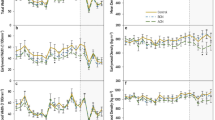Abstract
Pruning of agroforestry trees, while reducing shade of the crops, usually reduces both biomass production and nitrogen fixation. Short pruning cycles are often not sustainable on the long run, because tree production declines over subsequent pruning cycles. We compared biomass and labile carbohydrate dynamics of Erythrina lanceolata Standley (Papilionaceae) shade trees under total and partial pruning regimes in a vanilla (Vanilla planifolia L.) plantation in South-western Costa Rica. The highest biomass production was measured in the unpruned control, followed by trees with 50% of the leaf pruned every three months, while total pruning every six months resulted in the lowest biomass pruduction. In the more productive treatments, a higher proportion of the production was in branches. Because, the N content of woody branches was high, they were important for nitrogen cycling. In the partial pruning treatment more nitrogen was returned to the soil from litter and woody branches than from pruned leaf. Sugar concentrations were not different between treatments and the dynamics of non-structural carbohydrates (sugar and starch) seems to depend more on plant phenology than pruning treatment. However, the starch concentrations in the total pruning were lower than in the other treatments.
Similar content being viewed by others
References
Berninger F. and Nikinmaa E. 1997. Differences in pipe model parameters determine differences in growth and affect response of Scots pine to climate change. Funct Ecol 11: 146–156.
Berninger F., Nikinmaa E., Sievänen R. and Nygren P. 2000. Modelling reserve carbohydrate dynamics, regrowth and nodulation in a N2 fixing tree managed by periodic prunings. Plant Cell Environ 23: 1025–1041.
Davidson R. 1969. The effect of root/leaf temperature on root/shoot ratio of some pasture grasses and clover. Ann Bot 33: 561–569.
Duguma B., Kang B.T. and Okali D.U.U. 1988. Effect of pruning intensities of three woody leguminous species grown in alley cropping with maize and cowpea on an alfisol. Agrofor Sys 6: 19–35.
Erdmann T.K., Nair P.K.R. and Kang B.T. 1993. Effects of cutting frequency and cutting height on reserve carbohydrates in Gliricidia sepium (Jacq.) Walp. For Ecol Manag 57: 45–60.
García H., Nygren P. and Desfontaines L. 2001. Dynamics of nonstructural carbohydrates and biomass yield in a fodder legume tree under different harvest intensities. Tree Physiol 21: 523–531.
Holdridge L.R. and Poveda L.J. 1975. Arboles de Costa Rica. Tropical Science Center, San José, Costa Rica, 546 p.
Kass D.C.L. 1994. Erythrina species - pantropical multipurpose tree legumes. In: Gutteridge R.C. and Shelton H.M. (eds), Forage Tree Legumes in Tropical Agriculture. CAB International, Wallingford, pp. 86–94.
Lehmann J. and Zech W. 1998. Fine root turnover of irrigated hedgerow intercropping in Northern Kenya. Plant Soil 198: 19–31.
Mäkelä A. 1988. A carbon balance model of growth and self-pruning in trees based on structural relationships. Forest Sci 43: 7–24.
Miah M.G., Aragon M.L. and Garrity D.P. 1997. Growth, Biomass production and distribution of three multipupose tree speces in an agroforestry system as affected by pruning. J Trop For Sci 10: 35–49.
Nair P.K.R., Buresh R.J., Mugendi D.N. and Latt C.R. 1999. Nutrient cycling in tropical agroforestry systems: myth and science. In: Buck L.E., Lassoie J.P. and Fernandes E.C.M. (eds), Agroforestry in Sustainable Agricultural Systems. CRC, Boca Raton, pp. 1–31.
Nikinmaa E. 1992. Analysis of the growth of Scots pine: matching patterns with function. Acta Forestalia Fennica 235: 1–68.
Nygren P. and Campos A. 1995. Effect of foliage pruning on fine root biomass of Erythrina poeppigiana (Fabaceae). In: Sinoquet H. and Cruz. P. (eds), Ecophysiology of Tropical Intercropping. INRA, Paris, France, pp. 295–302.
Nygren P., Cruz P., Domenach A.M. and Vaillant V. 2000. Influence of forage harvesting regimes on dynamics of biological dinitrogen fixation of a tropical woody legume. Tree Physiol 20: 41–48.
Nygren P., Rebottaro S. and Chavarría R. 1993. Application of the pipe model theory to non-destructive estimation of leaf biomass and leaf area in pruned agroforestry trees. Agroforestry Systems 23: 63–77.
Nygren P., Kiema P. and Rebottaro S. 1996. Canopy development, CO2 exchange and carbon balance of a modelled agroforestry tree. Tree Physiol 16: 733–745.
Nygren P. and Ramírez C. 1995. Production and turnover of N2 fixing nodules in relation to foliage in periodically pruned Erythrina poeppigiana (Leguminosae) trees. Forest Ecol Manag 73: 59–65.
Palm C.A. and Sanchez P. 1990. Decomposition and nutrient release patterns of the leaves of three tropical legumes. Biotropica 22: 330–338.
Romero F., Montenegro J., Chana C., Pezo D. and Borel R. 1993. Cercas vivas y bancos de proteína de Erythrina beteroana manejados para la produccíon de biomasa comestible en el tró pico hú medo de Costa Rica. In: Westley S.B. and Powell M.H. (eds), Erythrinas in the New and Old Worlds. 205–210 Nitrogen Fixing Tree Research Reports. Westley S.B. and Powell M.H. (eds) Erythrinas in the New and Old Worlds. 205- 210 Nitrogen Fixing Tree Research Reports.
Sanginga N., Danso S.K.A., Zapata F. and Bowen G.D. 1994. Influence of pruning management in P and N distribution and use efficiency by N2 fixing and non-N2 fixing trees used in alley cropping systems. Plant Soil 167: 219–226.
Schroth G. and Kolbe D. 1994. A method of processing soil core samples for root studies by subsampling. Biol Fertil Soils 18: 60–62.
Schroth G. and Zech W. 1995. Root length dynamics in agroforestry with Gliricidia sepium as compared to sole cropping in the semi deciduous rainforest zone of West Africa. Plant Soil 170: 297–306.
Author information
Authors and Affiliations
Corresponding author
Rights and permissions
About this article
Cite this article
Frank, B., Eduardo, S. Biomass dynamics of Erythrina lanceolata as influenced by shoot-pruning intensity in Costa Rica. Agroforestry Systems 57, 19–28 (2003). https://doi.org/10.1023/A:1022910310082
Issue Date:
DOI: https://doi.org/10.1023/A:1022910310082




